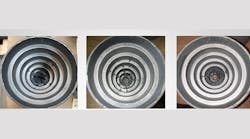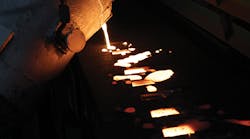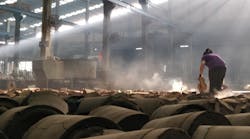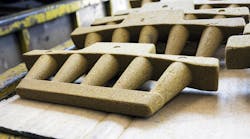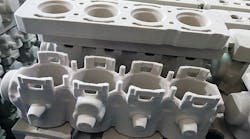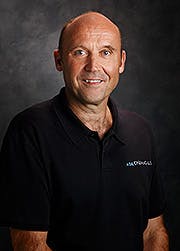Projects and knowledge are managed centrally, and our business lines — INOTEC, cold-box and no-bake binder systems, refractory coatings and engineered sand additives, auxiliaries, feeders, filters, and metallurgy products — benefit from this arrangement.
Our research department has developed several industry-changing technologies (e.g., cold box technology) and yet our commitment to R&D is displayed in less revolutionary ways, too. We focus on enhancing current offerings to optimize performance, as well as improved process reliability. This requires us to collaborate with the customers — a value-adding approach.
ASK Chemicals has invested in botha highly trained workforce and new equipment. Last year, we updated our laboratory in Hilden, Germany with new core shooters. In Dublin, we added gas chromatography that allows us to quantify airborne emissions during core and mold making, as well as throughout the metal casting process, i.e. pouring, cooling and shakeout.
Q: Aren’t R&D and innovation the same thing? A: Breakthrough innovations are extremely rare. Often, they are discovered through process optimization efforts and involve multiple parties. R&D is an effort to refine and perfect existing technology and processes. Most industry changes, therefore, are evolutionary, not revolutionary. Nevertheless, major breakthroughs have the greatest impact on furthering our industry. For this reason, ASK Chemicals dedicates resources toward the discovery of brand new technology. An example is 3D printing: ASK Chemicals has been developing “printing inks” for core, mold and model building, but we also are exploring the creation and manufacture of custom-shaped articles, like risers and filters.Q: How does ASK Chemicals coordinate marketing, R&D, and production? A: The interface between product management/marketing and R&D enjoys special importance. R&D is a “back office” function that connects to the customer-facing functions (marketing and technical sales) through business line management. ASK Chemicals is organized to operate like a matrix, interfacing on both the regional and global levels, and as such making it possible to achieve short-, medium-, and long-term corporate objectives.Q: What are the core competencies supporting ASK Chemicals’ R&D and innovation effort? A: Process efficiency. This is the single greatest attribute of our team. It stems from the deep understanding of foundry processes, systems and products. Our research centers and labs around the globe are in constant communication about products, testing and best practices. The confluence of development, process simulation and in-house metalcasting capabilities, paired with close cooperation with manufacturing, results in customized solutions that address our clients’ specific requirements. Q: How does R&D prioritize the rising demand for resource and energy efficiency? A: Globally, environmental regulations are becoming stricter. Changing socio-economic demands for the development of environmentally compatible and resource-conserving products and processes are just as challenging, and we are addressing this important issue head-on. We’re committing research personnel to tackle environmental issues through new developments, as well as modifying existing technologies. Improving performance, in particular, is of major interest. A more efficient product means less consumption, which naturally has its benefits.The present and the future are linked by continuous improvement of established technologies, with great value placed on the resulting products’ ability to set the new competitive standard. However, this approach does not deter us from the challenge to close this gap between “now” and “then” with clear vision for conceiving and realizing new concepts to practice, keeping practicability and cost-effectiveness in mind.
Join the Conversation. Email Your Questions for ASK Chemicals
Share your insights, opinions, and elaborate on the questions and the experts' answer(s). You must be logged in to the website in order to post your comments.

